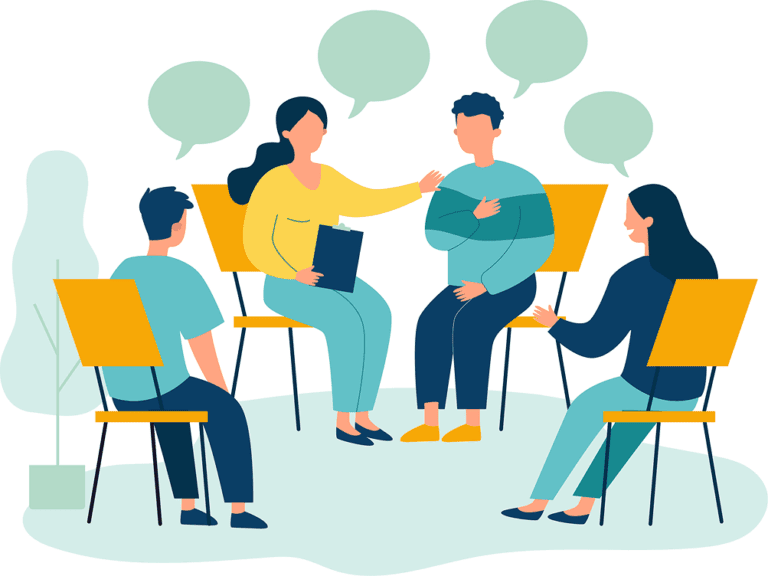Life After Alcohol Rehab
Support and continuing care after rehab can help to maintain long-term recovery.
Navigating Life After Alcohol Rehab
Transitioning from an inpatient rehab facility to everyday life comes with an array of challenges. The recovery process is a lifelong journey and alcohol rehab is only the first step along the road to getting and staying sober. The next step after rehab is establishing a recovery plan that reinforces the lessons you learned while in rehab.
Creating a long-term recovery plan with an addiction specialist keeps you focused on maintaining your sobriety. The more specific and detailed your goals, the greater your chances of staying alcohol-free. Without a concrete plan in place, you are more likely to fall back into old habits.
The most effective alcohol recovery plans will include:
- Listing goals and specific steps on how to achieve each one
- Rebuilding damaged relationships with family and friends through the help of counseling sessions and group therapy
- Finding alcohol-free activities and hobbies to participate in
- Joining local support group meetings
- Recognizing impulses and learning how to handle them
Life after alcohol rehab can seem like a maze with no end in sight. No matter your situation or how long you’ve been out of treatment, help is available. Treatment providers are available to help and support sobriety. Contact a treatment provider to learn more about alcohol treatment and recovery options available nearby.
What Happens After Alcohol Rehab?
After successfully completing an alcohol rehab program, it takes time to readjust back into normal life. Personal and professional responsibilities can quickly pile up, so be sure not to take on too much directly after completing rehab.
Some things you should prepare for prior to leaving rehab include:
- Finding living arrangements
- Establishing a healthy daily routine
- Looking for local support groups
- Arranging meet-ups with sober friends
- Keeping a distance from potential triggers
- Learning when to ask for help
Life after rehab can feel like a rollercoaster of highs and lows. Because of this, only around 20 percent of patients remain alcohol-free for a full year after treatment. However, individuals who make it past the first year of recovery significantly increase their chances of staying sober. After two years of sobriety, the relapse rate drops to 40 percent. Every additional alcohol-free year reduces the risk of relapse.
Paid Advertising. We receive advertising fees from purchases through the BetterHelp links below.
Online Counseling for Alcohol Addiction
Online therapy can help you with long term addiction support. Start your therapy journey with BetterHelp.
- Personalized Matching Process
- Easy Online Scheduling
- 20,000+ Licensed Therapists
- Personalized Matching Process
- Easy Online Scheduling
- 20,000+ Licensed Therapists
Sobriety Milestones
Recovering from alcoholism is a lifelong process. Maintaining your sobriety requires time and hard work – both during and after treatment.
Here’s a breakdown of the 30-day, three-month, six-month and one-year recovery milestones.
30 Days After Alcohol Rehab
Alcohol rehab provides a safe and structured environment to focus on recovery. However, situations outside the facility may seem nerve-wracking and stressful. It’s important to ease yourself back into the swing of things. Take your time to organize a balanced schedule and set boundaries that will help you maintain sobriety.
Within the first 30 days of sobriety, try the following tips:
- Attend at least two local support group meetings to help you decide which one is right for you.
- Establish someone (a therapist, family member or loved one) you can call if you ever feel triggered to drink.
- Incorporate physical activity such as walking, jogging or yoga into your weekly routine to clear your mind and improve overall health.
Three Months After Alcohol Rehab
By the 90-day mark, you will begin to notice a difference in how you feel both physically and emotionally. As time passes, the urge to drink will diminish and cravings should subside. Stay involved in support group meetings and counseling sessions on a regular basis, even if you’re starting to feel like your normal self again.
Some tips to try in the third month:
- Start a journal of your recovery process to jot down any triggers and ways you overcame them.
- Meet with a career counselor to discuss your professional goals now that your sobriety is in a more stable spot.
Six Months After Alcohol Rehab
Remaining alcohol-free for six months after rehab is a huge milestone. While you may have had a mix of good and difficult days, you will really begin to see the progress you’ve made. Realizing how far you’ve come will re-energize and motivate you to stick with your recovery plan.
Your 6-month alcohol-free lifestyle should include:
- Starting to repair broken friendships and relationships.
- Meeting with a financial advisor to establish short- and long-term goals (spending, saving accounts, etc.).
- Attending a career fair to network with potential employers or find better work opportunities.
- Taking on a new hobby or extracurricular activity, such as music, art or writing.
1 Year After Alcohol Rehab
The first anniversary of your sobriety is a significant event. This is a great opportunity to celebrate with those who have supported you along the way. Reward yourself by going out to dinner, getting tickets to a concert or sports game, or participating in a fun activity of your choice.
After your first full year of sobriety, try these tips:
- Share your recovery story with groups of people just entering treatment.
- Make a five-year plan of future goals, both personal and professional.
- Look for new ways to motivate yourself in your continued sobriety.

Need Addiction Support?
Reach out to a treatment provider today! Calls are always free and confidential.
Types Of Aftercare Programs
There are countless aftercare programs available across the nation. While each one will encourage members to stay healthy and sober, it’s important to find a program that offers the treatment you are looking for. Common types of alcohol aftercare programs include sober living homes, individual counseling, family therapy and support groups.
Before leaving rehab, talk to your treatment provider about community-based recovery options. This is also a great time to start developing your long-term recovery plan and addressing any concerns that you may have about life after rehab.
Sober Living Homes
After rehab, some people move into a sober living home. This is especially beneficial for those involved in an unstable home environment before treatment. Sober living homes not only provide a safe, alcohol-free environment, they also encourage individuals to seek help from local alcoholism groups and counselors.
Studies have found that sober living homes improve abstinence rates, reduce alcohol-related crimes and increase the number of individuals who find employment after rehab. Without the worry of whether you’re going home to a healthy, safe environment, people in recovery can focus more on their future plans and staying sober.
Individual Alcohol Counseling
While in rehab, you will meet with an alcohol counselor several times each week. This will help identify any underlying mental health issues and begin the process of emotional healing.
Once out of rehab, individual counseling remains a crucial step in recovery. Sessions are typically conducted on a weekly basis, depending on the individual. These meetings are meant to help you adjust back into your personal and professional responsibilities.
As you progress in your recovery journey, the frequency of your counseling sessions may begin to decrease. However, it’s important to check in with your therapist on a regular basis to evaluate your recovery goals and outcomes. Some therapists will even suggest you call them if you experience triggers and need advice on how to cope.
Family Therapy
Alcoholism affects more than just an individual; it also impacts those closest to them. After rehab, you may notice that your relationships with family members and friends have changed. There are many factors that can contribute to strained relationships while in an active addiction. Patterns of manipulation, cheating, stealing or abusive behavior are common among those suffering from the grips of addiction. Over time, these actions can negatively impact relationships with loved ones.
Rebuilding relationships with family and friends takes patience and determination. A family therapist can help you, your family members or friends learn how to communicate effectively and mend your relationships. Oftentimes, a counselor will meet with each person individually, and then bring everyone together to work through difficult situations.
Support Groups
Your social group can have one of the biggest influences on your sobriety. Individuals who surround themselves with sober peers increase the likelihood of maintaining an alcohol-free lifestyle.
Alcohol support groups are a great way to create new friendships with others who understand the challenges you’re going through. These relationships provide a support system when you need it most and give you an opportunity to help those around you.
National support groups include Alcoholics Anonymous, which is for the person in recovery, and Al-Anon, which is a support group for their families. Smaller, more specific groups are generally geared towards different age groups, genders and populations affected by addiction (family members and friends). Support groups vary by city, so check with your treatment provider or counselor to find the ones closest to you.
Every year, more than five million individuals attend support group/self-help meetings in the United States. The most successful alcohol treatment programs focus on the person as a whole, rather than just their addiction. Sober living homes close the gap between an inpatient rehab setting and everyday life. They focus on prevention and establishing healthy living.
Alcohol Help is not affiliated with any insurance.
Benefits Of Aftercare Programs
A comprehensive alcohol treatment plan is essential for long-term sobriety. This includes inpatient or outpatient rehab, medication-assisted therapies, counseling sessions and alcohol recovery programs. Ongoing recovery programs provide you with the necessary tools and resources for maintaining an alcohol-free lifestyle.
Several benefits of attending an alcohol recovery program include:
- Learning about how to prevent a relapse in various circumstances
- Connecting you with local individuals in recovery who can offer support and encouragement
- Providing a safe space to discuss recovery, including accomplishments and pitfalls
- Building confidence and self-esteem to overcome urges and triggers
- Offering fun sober meetups and activities for group members
Help Is Out There
Find out more about alcoholism resources and support options available now.
With so many recovery programs out there, it can be challenging to narrow your list down to just one. It’s important to explore options.
Talk with a treatment provider to learn more about alcohol recovery programs.






